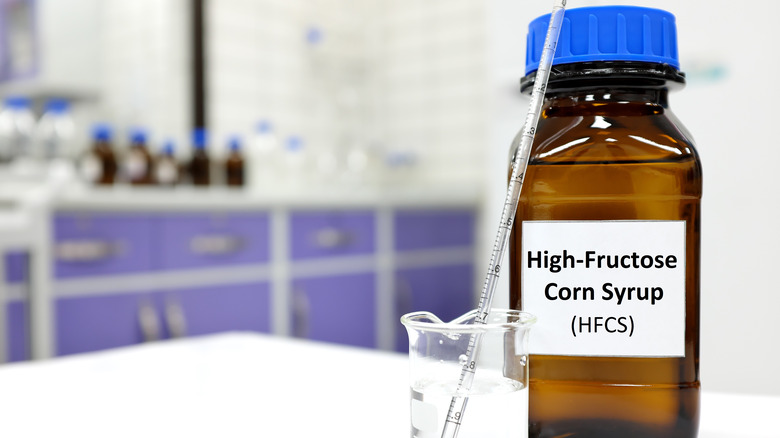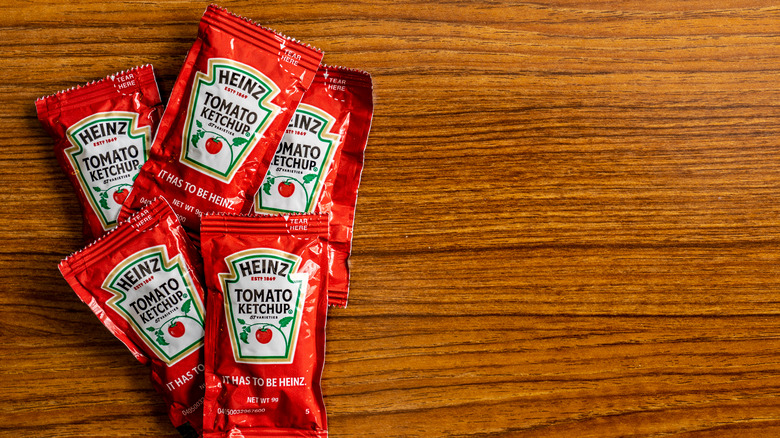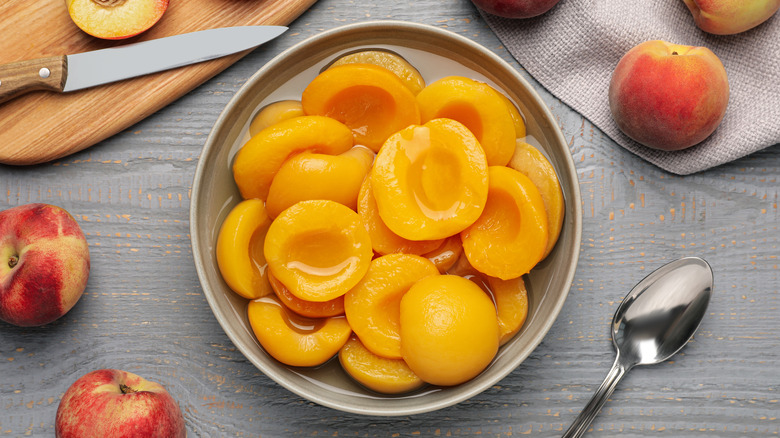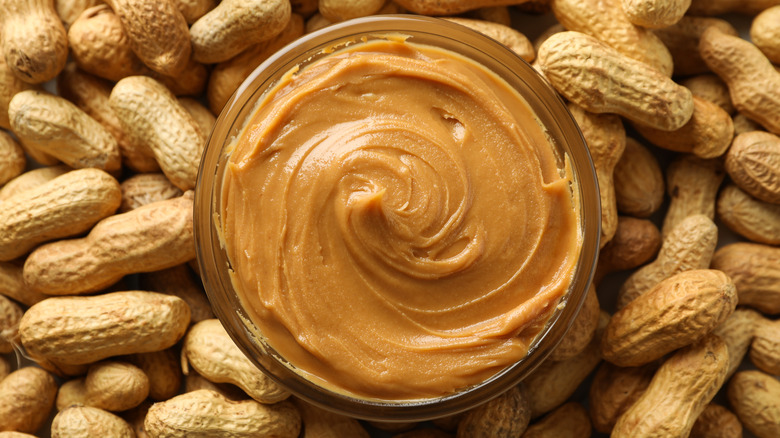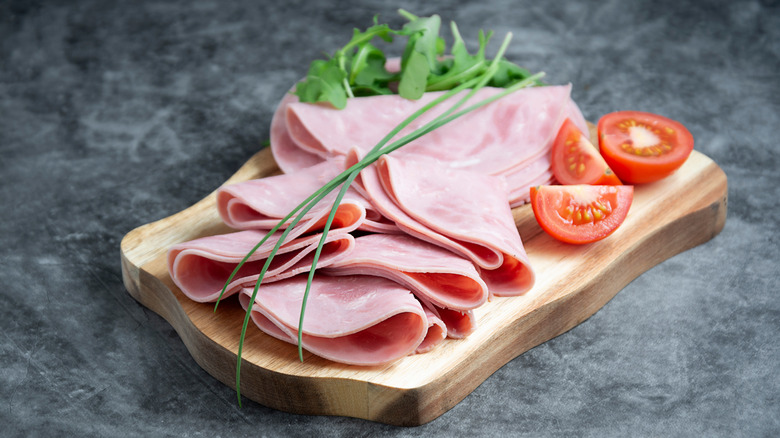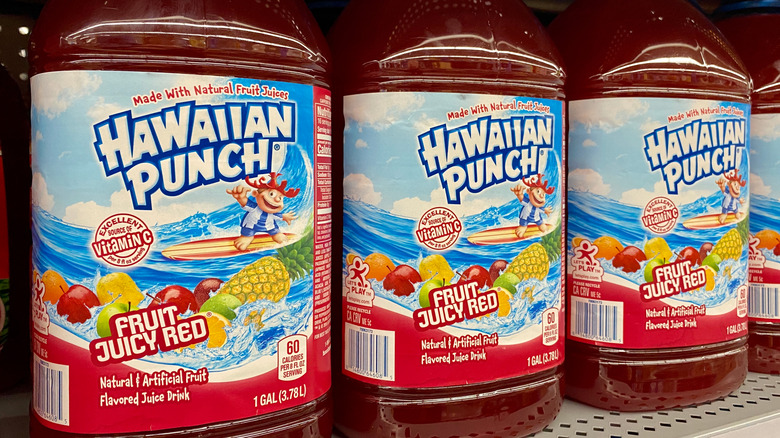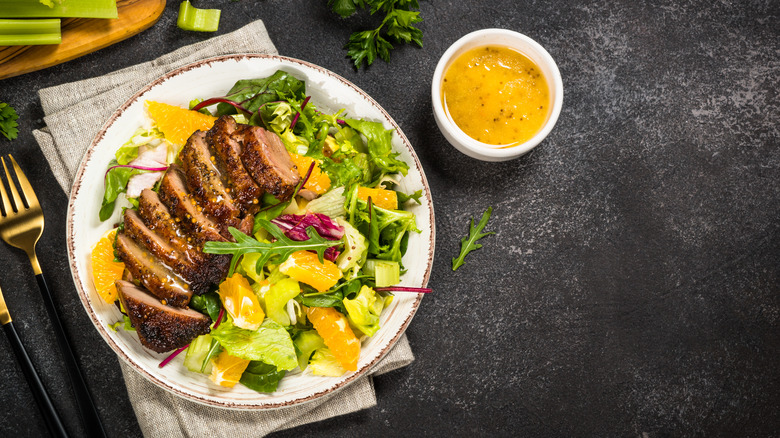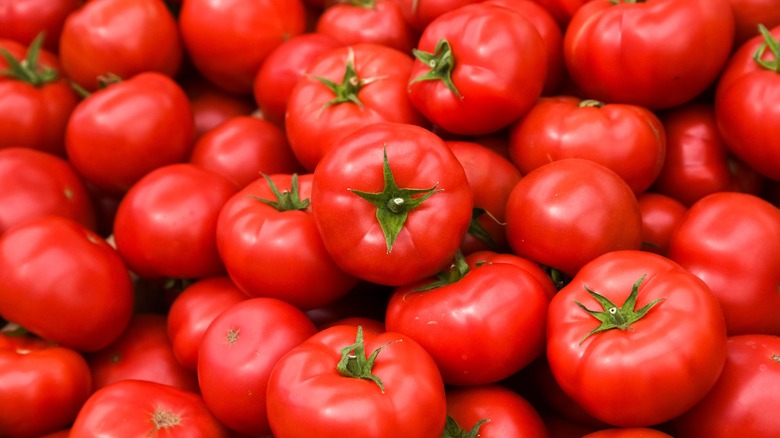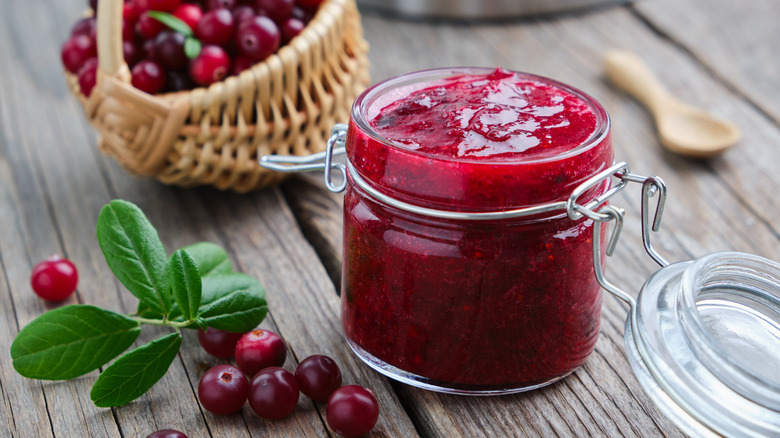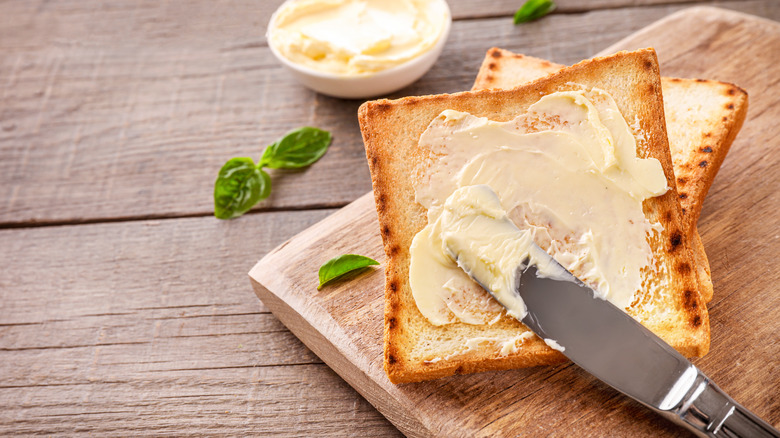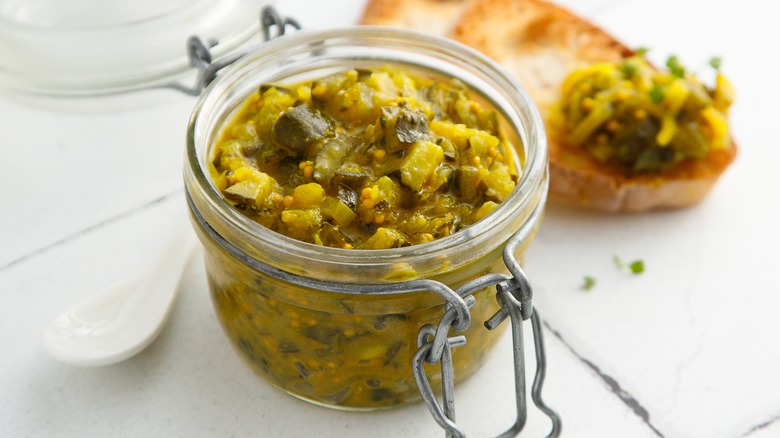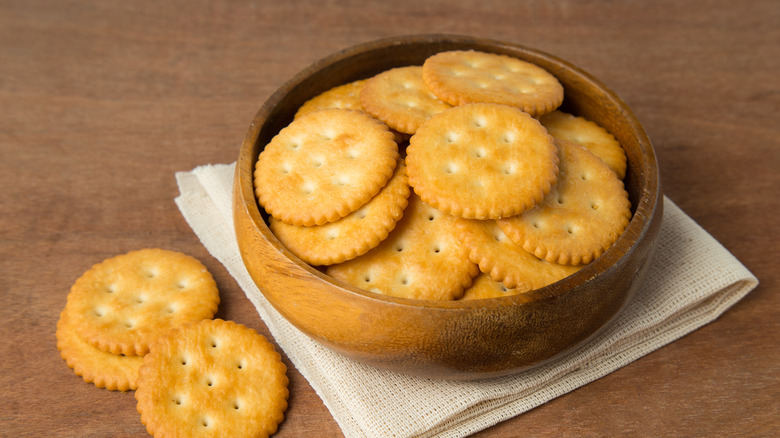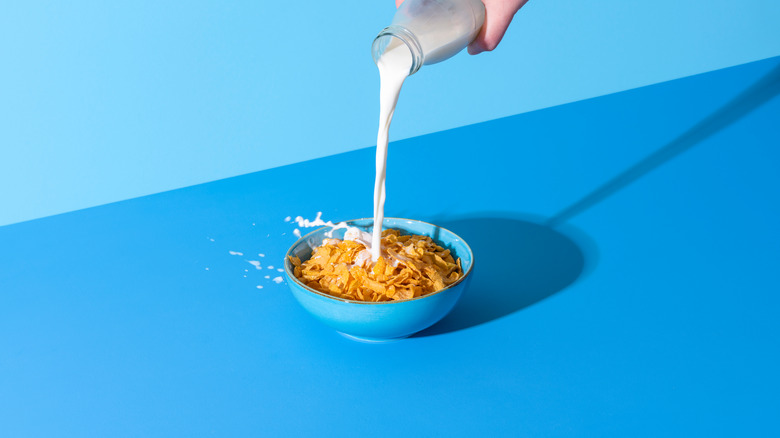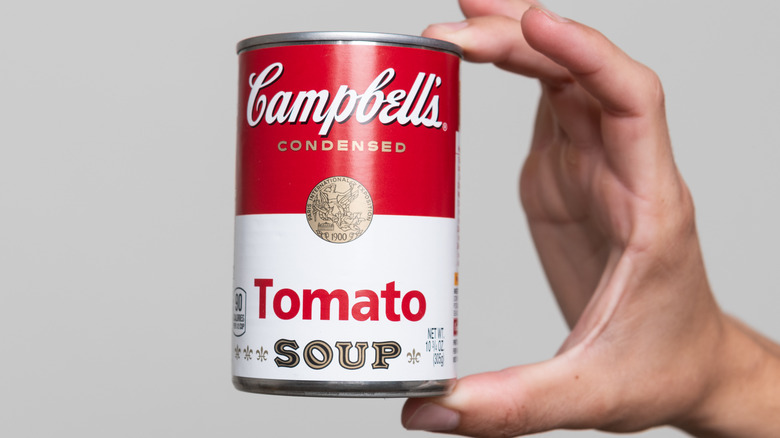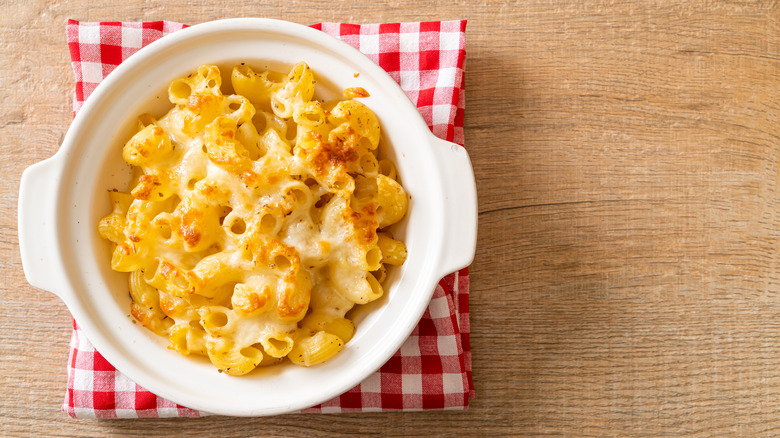Unexpected Foods That Contain High Fructose Corn Syrup
We may receive a commission on purchases made from links.
We all like things to be a little sweeter now and again. And when that craving rears its head, boosting the sweetness of our foods through adding sugar or artificial sweeteners is common practice for a lot of people. But for some folks — and food companies — sugar doesn't cut it. And when that happens, they may reach for high fructose corn syrup (HFCS), a man-made sugar derived from regular corn syrup (per Healthline).
High fructose corn syrup can supercharge your food's sweetness, thanks to its abundant fructose content. But eating large amounts of fructose, which has to undergo a conversion process in the body before it can be used as fuel, is not something that generally used to occur in everyday diets, due to the sugar being previously only available in natural foods. As a result, the higher amounts of fructose in foods today can present some pretty significant health concerns and have been linked to increased incidences of diabetes, fatty liver disease, obesity, and inflammation. And the worst part is, these days, high fructose corn syrup is snuck into pretty much everything – including some foods you seriously wouldn't expect. We take a look at some of the most surprising sources below.
Ketchup
As ketchup is the ultimate condiment for a range of savory snacks and meals, it's understandable that you wouldn't expect it to be super-sweet. But have you ever stopped to really taste your favorite ketchup? It's way sweeter than we think — and a large part of that is thanks to high fructose corn syrup. Your favorite bottle of Heinz ketchup actually gets its sweetness from both high fructose corn syrup and regular corn syrup for a double dose of sugar.
But surely that's not the worst thing in the world, right? In fact, this very mindset might be causing you to make unintentionally poor dietary choices. When it comes to ketchup, "it's deceiving because it has no fat, so people think they can enjoy freely. Unfortunately, we now know that sugar is far more insidious than fat," states registered dietitian Monica Auslander to The Healthy. And as Auslander also notes, just a teaspoon of the red stuff is the same as eating a packet of sugar. If you're trying to keep your sugar intake down, it's advisable to look for reduced-sugar ketchup variants, or else create your own ketchup using tomato paste, apple cider vinegar, and spices, as Auslander does.
Canned fruit
It can sometimes be difficult to get to the store every day to pick up fresh fruit. And for those moments where your recipe demands some peach or mango and your fruit bowl's looking a little bare, canned fruit can come to the rescue. Unfortunately, though, canned fruit may not be as healthy as we think, thanks to the addition of high fructose corn syrup, as WebMD states. Check out the ingredients list for Del Monte Yellow Cling Peach Canned Slices (via Walmart), which has high fructose corn syrup, corn syrup, and sugar, for a total of 14 grams of added sugar per serving. Not exactly the wholesome goodness we expect from fruit, is it?
It's important to remember that, while high fructose corn syrup might be technically derived from the sugars found in fruit and vegetables, eating it alongside canned fruit won't negate any of its potential health downsides. In addition to boosting your chances of obesity and liver conditions, high fructose corn syrup may also contribute to higher triglycerides, causing a knock-on effect on your pancreas, and can also increase your chance of developing gout. Don't be fooled by those cans of fruit.
Peanut butter
Honestly, sometimes we think that peanut butter is just the perfect food. With a perfect balance of salty, sweet, and savory, peanut butter goes well with anything. But, alas, not all peanut butter is created equal, and in some cases, it comes loaded with high fructose corn syrup, according to Medical News Today. This may not just be the case with peanut butter, either — other nut butters, like almond or cashew butter, might also have corn syrup lurking in their ingredients list.
Luckily, though, with the extensive range that the modern world gives us, there's a peanut butter out there for everyone, and many brands eschew high fructose corn syrup for a healthier vibe. The best way to choose your peanut butter is to follow a few simple rules: Keep it full-fat, try to avoid brands with added oils and emulsifiers, and crucially, look for a brand with no added sugar, says Eat This, Not That!. It's best to just keep it simple. "As a dietitian, I choose peanut butters that contain the fewest ingredients possible. If I can select a peanut butter that contains only peanuts and a touch of salt, that is the best choice in my book," states registered dietitian nutritionist Lauren Manaker to Eat This, Not That!.
Cold cuts
Okay, we gotta admit, this one blew our minds too. As slices of savory meat, cold cuts are pretty much the last place that you'd expect sugary high fructose corn syrup to show up. But show up it does, folks, with HFCS being an added ingredient in many deli meats, according to Eat This, Not That!. High fructose corn syrup is more likely to be a feature in cold cuts that have sweeter flavoring blends, like honey-smoked ham or BBQ-style meats, so be on your guard when you're purchasing these.
Remember, too, that high fructose corn syrup isn't the only additive you need to keep an eye on when it comes to your cold cuts. Cold cuts and other lunch meats can be especially high in sodium, a real problem if you're trying to watch your salt intake, says Verywell Fit. Other additives, like citric acid, sodium nitrite, and MSG may also show up in your cold cuts, according to Epicurious. And, above all, keep an eye on the general hygiene conditions when your food is being prepared by the butcher. "Did they wash their hands? If the slicer is in a cooler, that's awesome. But how often is the slicer cleaned?" Kansas State University professor and meat science specialist Elizabeth Boyle invites you to ask (via Epicurious).
Fruit juices
For a drink that you'd imagine is a healthy option, fruit juice sure doesn't make it easy for itself. And despite fruit juice's main component and flavorings coming from, well, fruit, that lip-smacking sweetness you get from it may not be just down to natural sugars. High fructose corn syrup is routinely added to fruit juice drinks, states Healthline. And it might be lurking in some of your favorite beverages, with products from Minute Maid and Hawaiian Punch containing the sweetener.
Remember that although fruit juices and juice drinks can provide you with a nutritional boost, their sugar content may diminish their health-giving properties (per Verywell Fit). And oftentimes, fruit juice may lack the soluble and insoluble fiber that comes with whole fruit, which provides such a benefit to our bodies. The relative lack of fiber and super-high sugar count in some fruit juices can have a significant impact on your blood sugar if you're drinking larger amounts. When selecting your fruit juice, try to opt for one that doesn't have any added sugar.
Salad dressings
When we put a salad dressing on an otherwise healthy salad, we rightfully expect it not to undo all of the wholesome goodness we're about to consume. But unfortunately, some salad dressings can do just that, and they may even be almost as bad as what you eat for dessert (per Eat This, Not That!). Take Ken's Fat Free Sundried Tomato Vinaigrette as an example — might seem innocuous, right? No fat, how bad can it be? Well, as it turns out, pretty bad. Just two tablespoons contain 70 calories and twelve grams of sugar, with high fructose corn syrup being the very first ingredient listed for the dressing. For comparison's sake, note that Hershey's Simply 5 Chocolate Syrup contains 90 calories for the same serving size — not a whole lot more.
Now we don't know about you, but we like our salads to be not doused in sugar. You'd be far better off making a simple vinaigrette at home — it's easy, and then you know exactly what's going on in your salad. In its most basic form, a vinaigrette is just oil and acid, but you can jazz it up with all-natural ingredients to create an all-star dressing, as Cookie+Kate shows.
Canned tomatoes
Call us old-fashioned, but when we buy canned tomatoes, we sort of expect them to be one thing and one thing only: tomatoes. But too often, you may be getting more than what you think in that tin. High fructose syrup may be added to canned tomatoes to increase their natural sweetness, according to Eat This, Not That!. This sugar can help to cut the natural acidity of the tomatoes and make them more palatable, as Epicurious explains.
The downside to this is that you may end up with a can that's got way more than you bargained for in it. The solution, though, is simple. Look for cans of tomatoes that have as short an ingredients list as possible, free from any preservatives (apart from citric acid, which plays a part in the canning of the tomatoes), says Bon Appétit. Ideally, your can of tomatoes should contain just tomatoes, maybe a little salt, and water or tomato juice. As for what type of canned tomatoes you should buy, it's always better to go for whole peeled than diced, as diced tomatoes often contain preservatives that help them maintain their shape but prevent them from fully assimilating into your dish. Just crush the whole peeled tomatoes yourselves, folks — your hands can come in handy here.
Cranberry sauce
For some people, the turkey is the star of the show at Thanksgiving, but if you're like us, you'll be craning your neck for the cranberry sauce. But what if we told you that part of the reason why that cranberry sauce is so delicious is because of some slightly dubious added ingredients? High fructose corn syrup is a frequent flyer in cranberry sauces, including some of the most popular options out there. Ocean Spray Jellied Cranberry Sauce even has high fructose corn syrup listed second in its ingredients list, after (as you might expect) cranberries, according to Walmart.
In our opinion, the best way to avoid having HFCS and other unwanted ingredients in your cranberry sauce is to make it yourself. A traditional cranberry sauce can be made with just a few simple ingredients, with whole cranberries, orange juice and zest, sugar, and spices making up The Healthy Epicurean's recipe. It's important to remember that, as cranberries can be very tart, a little sweetness here and there doesn't go amiss — but it's important not to overdo it.
Bread
Bread is a staple food, and in many cases, you can expect the ingredients list to be pretty basic (via The Spruce Eats). But some of the time, certain additions can sneak into your bread that can tip it into seriously unhealthy territory, with high fructose corn syrup working its way into several varieties of carby goodness, according to Fitday. And while you might expect HFCS to only show up in sweeter-seeming white loaves, think again: High fructose corn syrup can be at home in wheat bread recipes and products, as well as white loaves of bread.
As such, it's best to steer clear of bread varieties that have HFCS lurking on their label — and in fact, it might be smart to stay away from bread made from refined carbs, like white bread, entirely. Refined grains are created by stripping away all of the original grain's fibrous goodness, as well as its nutritional benefits like vitamins and minerals, says Healthline. The absence of fiber, in particular, can create problems for your blood sugar, as the refined carb will be processed way faster, jolting your blood glucose up. And if high fructose corn syrup is part of the equation? It'll only make it worse.
Relish
As with many condiments, we rarely think about the impact of a little dab of relish on our wider diets and health. But food companies, in their enthusiasm to create appealing, long-lasting products, can put way more in our everyday relish bottles than we think. More specifically, relishes can be a source of high fructose corn syrup, as in the case of Heinz Sweet Relish, which places HFCS pretty high up on its ingredients list. The high fructose corn syrup in the relish serves not only to give it a kick of sweetness, but to help preserve it longer, as Know Your Pantry indicates.
In our opinion, though, there's no need to compromise on your high fructose corn syrup intake just so you can enjoy a relish with your burgers. Relish is almost absurdly to make at home, with minimal ingredients. Simply grab two cups of finely chopped cucumbers and a half cup of chopped white onion, toss them with salt, and then leave to drain (per Epicurious). Then, boil them together with vinegar, a little sugar, and a touch more salt. Leave to cool, refrigerate, and enjoy whenever you please!
Ritz crackers
How much harm can a humble cracker do? More than you may think. While a simple Ritz cracker might seem pretty innocuous, that little bite contains a multitude of nutritional considerations you might want to bear in mind. Most notable is the cracker's high fructose corn syrup content, as Ritz shows. This sugar boost added to the Ritz recipe may taste good, but it also provides you with a slug of empty calories, and may partly contribute to an increased risk of several chronic conditions (per Livestrong).
And it doesn't stop there. Ritz crackers are also a source of trans fats via hydrogenated cottonseed oil, meaning that eating them in higher quantities may contribute to higher bad cholesterol levels. You're far better off seeking out crackers that are labeled as "whole grain" for a good source of fiber, and, crucially, which have negligible amounts of added sugar. "A little added honey is alright, but it's usually best to avoid high fructose corn syrup or crackers with more than one type of sugar," says dietitian Caitlin Self to Eat This, Not That!. "If you're looking for a healthy cracker choice, keep the added sugar in check: no more than 1-2 grams of sugar per serving is best."
Breakfast cereal
We just trust breakfast cereal, don't we? While the word might still be out as to whether a bowl of cereal with milk is a soup or not, what we can all agree on is that it's a reliable, easy way to start the day. But some ingredient lists on breakfast cereal boxes can be as lengthy as the aisle you buy them in, and high fructose corn syrup is a repeat offender in a wide range of cereals (per Healthline). If you've ever wondered where that sweet taste comes from, there's your answer.
As such, we recommend being a little more discerning with your cereal choices and going for the healthy options out there. Cereals that are made with whole grains are high-priority, as they'll contain an abundance of vitamins, minerals, and fiber that might not be present in refined grain varieties (per Fitday). Crucial, too, is to seek out cereals that have little to no added sugar or fat — and, of course, that don't have HFCS in them. Plain Shredded Wheat, Raisin Bran, Whole Grain Cheerios, and good old oatmeal are all solid choices.
Canned soup
We've gotta admit, this one made us feel a little queasy for some reason. Maybe it's the fact that we tend not to associate canned soup, as a savory meal, with sugary sweetness. Maybe it's the fact that we tend to associate it with being wholesome, a soothing balm when you have a cold or the flu. But certain canned soup varieties can be loaded with less-than-ideal ingredients, with high fructose corn syrup taking center-stage, according to Know Your Pantry. HFCS even shows up in some of the most well-known brands on the market today, like Campbell's Tomato Soup (per Campbell's).
In our opinion, though, there's no reason why a nourishing bowl of soup should be made unhealthier in the name of taste when it's perfectly possible to enjoy canned soup without high fructose corn syrup. We'd recommend seeking out options that have no added sugar, and always checking the ingredients list. Or, simply rustle up a copycat Campbell's Tomato Soup at home! Throw some chopped vegetables, tomato sauce, puree, and paste into a pan with some broth and seasonings, simmer together, add whole milk and blend, advises Mantitlement. Adding a little sugar in this recipe will give a hint of sweetness, too.
Mac and cheese
It's fair to say that most recipes for mac and cheese probably aren't going to win any prizes for health. But if you can believe it, some food companies seem determined to push their mac and cheese into even more unhealthy territory by adding corn syrup. Kraft Original Macaroni and Cheese Easy Microwavable Dinner cups do this in a particularly interesting way, with the addition of "corn syrup solids" in their cheese sauce mix, alongside an eyebrow-raising amount of other ingredients (via Walmart).
Corn syrup solids are created by dehydrating corn syrup until it dries out, giving you a serious hit of sugar, as Livestrong explains. This dried version of corn syrup can also make its way into powdered drink mixtures, coffee sweeteners and creamers, and even baby formula. While we totally understand the appeal of an easy, microwaveable mac and cheese, the best way to make sure tricksy sugar sources aren't working their way into your meal is to make it yourself — and adding sweetness via alternatives to refined sugar, like stevia, honey, maple syrup, or date syrup, may give it a little nutritional benefit, as Healthline explains.
